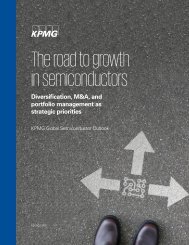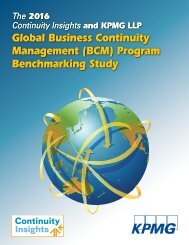Revenue for Telecoms
2cdncba
2cdncba
You also want an ePaper? Increase the reach of your titles
YUMPU automatically turns print PDFs into web optimized ePapers that Google loves.
<strong>Revenue</strong> <strong>for</strong> <strong>Telecoms</strong> – Issues In-Depth | 175<br />
10.3 Accounting <strong>for</strong> payments in the indirect channel |<br />
Handset discount reimbursement<br />
Telco A observes that the reimbursement related to the handset is ultimately<br />
a discount provided to the end customer. This is because there is a direct<br />
correlation between the amount paid to Retail Store X and the discount provided<br />
by Retail Store X to the end customer; the amount is only paid to Retail Store X<br />
when the customer activates the service plan, and Retail Store X provides<br />
evidence of the discount provided to Telco A’s customer. In this arrangement,<br />
Retail Store X passes through a discount to the end customer that is funded by<br />
Telco A. Consequently, Telco A concludes that the reimbursement is consideration<br />
payable to a customer (i.e. the end customer). Telco A recognizes the<br />
reimbursement to Retail Store X as a reduction of the service transaction price.<br />
Example 70 – Payments in the indirect channel: When judgment is<br />
required<br />
Continuing Example 68, Retail Store X acts as a principal in the sale of handsets<br />
to end customers.<br />
The agreement between Telco A and Retail Store X also specifies that Telco A<br />
will make certain payments to Retail Store X when Retail Store X sells a service<br />
plan to a customer. The agreement specifies that the payment is 500 when Retail<br />
Store X sells a service plan with a handset and 100 when Retail Store X sells the<br />
same service plan alone.<br />
Telco A determines that the amount paid to Retail Store X is paid in Retail<br />
Store X’s capacity as an agent, not a customer. This is because the payment is<br />
only payable when Retail Store X sells a service plan to an end customer which, in<br />
the case of service plans, is Telco A’s customer.<br />
Be<strong>for</strong>e concluding that the full payment of 500 should be capitalized as a cost to<br />
obtain the service contract, Telco A observes that the difference in the amount<br />
paid between types of contracts sold by Retail Store X may require additional<br />
analysis. In particular, the higher amount paid to Retail Store X when it sells a<br />
handset and a service plan suggests that the amount paid may be something<br />
other than a commission and may represent a reimbursement of discounts<br />
commonly provided to end customers in the purchase of handset and service<br />
arrangements. In assessing whether the payment should be accounted <strong>for</strong> as<br />
something other than a commission, Telco A considers the difference in the<br />
commission payments and the typical discounts provided to end customers in<br />
the purchase of handset when it is bundled with a service contract. Telco A also<br />
considers other in-market offerings that provide a significant discount on the<br />
handset when it is bundled with a service offering.<br />
© 2016 KPMG LLP, a Delaware limited liability partnership and the US member firm of the KPMG network of<br />
independent member firms affiliated with KPMG International Cooperative, a Swiss entity. All rights reserved.<br />
© 2016 KPMG IFRG Limited, a UK company, limited by guarantee. All rights reserved.<br />
Home







